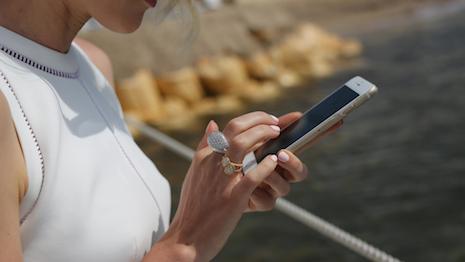- About
- Subscribe Now
- New York,
December 1, 2016

 Photo courtesy of jeweler Boucheron
Photo courtesy of jeweler Boucheron
Advances in social media have refined brand building and strengthened awareness tactics, particularly when a new product is launched, according to a report from Five by Five.
In its “2017 Launch Marketing Report,” Five by Five found that 76 percent of marketers prioritize social media when planning a new product’s market debut. Social media is the ideal channel for luxury product launches due to its visual nature and the opportunity for active followers to interact with the item, whether that is defined by positive or negative reviews, point of sale inquiry or peer-to-peer recommendations.
"Social media has become the most important way to generate buzz for new products and services before they appear," said Michelle Mitchell, strategy director at Five by Five. "Shareable content and social engagement allow brands to create a groundswell of pre-launch interest in a way no other channel can match.
"This means that while deadlines may have got tighter, and costs have risen, marketers are more informed than ever," she said. "This increased knowledge base means campaigns are braver, smoother and more effective.
"However, there is still room for improvement. Our research shows senior marketers that if you want to ensure launch success you need to establish effective communication internally, align with external agencies successfully and make sure you invest the right amount of time and budget."
Five by Five interviewed more than 730 senior marketers in the United Kingdom, United States and Australia for the report. The interviews included 55 brand marketers in the luxury goods industry.
Launch off
As a whole, the marketing industry has noted the usefulness of social media, with 74 percent of marketers prioritizing the medium during planning.
Specifically in the luxury sector, social media is ranked as the most important channel in a marketer’s toolbox. Press advertising is second at 55 percent while sales promotion and email tie for third with 47 percent.
Expectedly, television is ranked fourth at 44 percent. Television's low ranking by marketers is also reflected by consumer sentiment, with only 6 percent citing TV spots as a factor in purchasing a new product.
Consumer discovery is now firmly rooted in social media exploration, which has caused marketers to push out relevant content at a much faster pace than in the past.
According to the report, eight out of 10 luxury marketers, or 79 percent, claim the average time between an idea and product launch has shrunk in five years' time. Sixty-seven percent of marketers said they typically only have about a six month window to prepare for launch.
Image courtesy of Instagram
Although social media is keen for consumer interaction via comments, likes and mentions, only 60 percent of marketers use social listening tactics to support the development of a new product.
"Social media puts the consumer in control of your brand, which could build it or demolish it," Ms. Mitchell said. "It therefore offers democratization of your brand building.
"It also has the potential to fast track brand growth if a brand can deliver enough relevancy and a great experience that consumers want to advocate your brand," she said.
Of those interviewed, 40 percent of luxury marketers feel that social media’s most important benefit is the ability to generate awareness and buzz prior to a product’s launch.
Social media-based product launches have also afforded marketers space to develop creative ideas, with 76 percent agreeing that debuts have “become braver.” With that said, 91 percent of marketers now believe that launch campaigns are more measurable thanks to social media.
Five by Five’s report also highlighted factors that can threaten the successfulness of a new product or service launch. The three main factors include ineffective communications, slow processes and a lack of budget, a challenge for many as a number of marketers feel that launch campaigns are becoming more expensive.
Social practices
Social media campaigns and product launches are commonly positioned together, and do not need to be just a shared image and link to ecommerce.
Including elements of interaction, whether that is a Snapchat-enabled scavenger hunt or a personalized Pinterest board, for example, ensures that a consumer enjoys the effort and is inspired to make a purchase.
For example, Swiss label Bally recently collaborated with artist André Saraiva on an updated vintage boot style, a capsule of leather goods and limited-edition posters of his Mr. A character pictured in a branded scene.
As part of the celebration for the collection and Bally’s first graphic poster in 25 years, the brand is using Snapchat to encourage consumer interaction. On Oct. 25, Bally placed the Bally x André poster in locations around New York as part of a mobile-activated scavenger hunt.
André Saraiva outside Bally's Madison Avenue storefront
Snapchat followers were then told to find three of the posters, Snapchatting as they discovered the artwork. The first 10 consumers to snap three posters and make it to the Bally boutique on Madison Avenue before 2 p.m. EST won a limited-edition poster signed by the artist (see story).
Also, British heritage brand Burberry demonstrated the importance of beauty personalization to introduce its latest mascara.
For the launch of Cat Lashes mascara, Burberry partnered with social platform Pinterest to create individualized inspiration boards based on consumers’ beauty preferences. Recently outfitted with ecommerce capabilities, Pinterest has emerged as the go-to platform for sharing favorite products, discovering new must-haves and exploring how-to tutorials, making it ideal for beauty promotions (see story).
"Social media is a crucial channel for launch. It enables marketers to be truly agile – something traditional channels simply cannot offer," Five by Five's Ms. Mitchell said. "Our research found that marketers believe that gathering real-time feedback about your product or service means you can change it and tweak it in those critical first weeks.
"Fine-tuning can also happen on an ongoing basis through the insights gained through social media," she said.
Share your thoughts. Click here